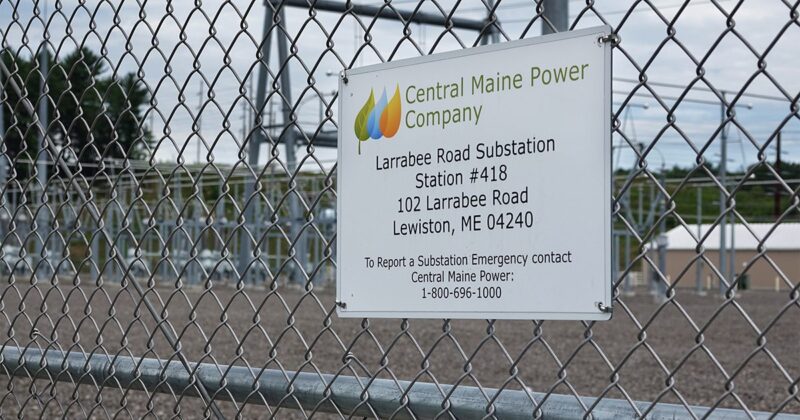The battle over Central Maine Power Co.’s controversial energy corridor remains quite active as citizen activists collect signatures for a potential second referendum bid to halt the project and several environmental groups challenge an analysis conducted by the U.S. Army Corps of Engineers.
The continued fight to thwart the project was overshadowed this week by a decision from the U.S. Army Corps of Engineers to grant a key fourth permit to Avangrid that potentially clears the way for construction to begin before the end of the year. Avangrid, CMP’s parent company, is owned by Iberdola, a multinational energy company based in Spain.
Before the federal permit was issued on Wednesday, the Appalachian Mountain Club, the Natural Resources Council of Maine and Sierra Club Maine challenged a U.S. Army Corps of Engineers environmental analysis of the billion-dollar New England Clean Energy Connect project in federal court.
“We felt it was important for us to sue them over (the environmental analysis) because it’s totally inadequate,” said Nick Bennett, a staff scientist at NRCM. “We didn’t want to just wait around for (the Army Corps) to twiddle their thumbs and issue a terrible permit. We can see where they’re going from their environmental analysis.”
The federal lawsuit pushes back on the Army Corps of Engineers’ analysis that there will be no significant environmental impact on a 53-mile swath of the proposed corridor. The lawsuit calls into question the decision to conduct an environmental assessment (EA) of the project instead of a complete environmental impact statement (EIS), which would have required the federal agency to take a more in-depth and rigorous look at the environmental impacts on western Maine.
“It’s a sloppy job on the part of the (Army) Corps, absolute minimal analysis of the issues,” said Bennett. “It’s not based on good science. It’s a very skimpy analysis of a very complicated issue.”
The groups argue that similar projects proposed for Vermont and New Hampshire underwent more scrupulous analysis of the environmental impact before the project landed in Maine’s North Woods. Bennett pointed out that the Corps’ environmental assessment of the western Maine corridor project was 163 pages while the environmental impact statement conducted for New Hampshire’s comparable Northern Pass project was over 3,000 pages.
Maine Youth for Climate Justice, a coalition of over 250 youth climate groups in the state, emailed a formal two-page request on Oct. 30 asking that the Army Corps of Engineers complete an environmental impact statement to ensure “the full scope of risks and hazards” are considered.
The appeal from MYCJ came the same day that Maine Secretary of State Matt Dunlap approved the application for a second citizen-initiated referendum campaign that could halt the construction of the corridor. Grassroots organizers collected 23,000 signatures on Election Day and need 63,000 signatures by Jan. 20 to present their referendum bid to the Maine legislature.
A potential second referendum battle has proponents concerned about the fate of the corridor proposal and other long-term renewable energy projects aimed at reducing Maine’s carbon footprint.
Jon Breed, the executive director of CMP’s political action committee Clean Energy Matters, told the Associated Press that the “new referendum is so broadly written that it could jeopardize other major renewable energy projects in Maine, including solar, wind and offshore wind projects,”
735 acres of ancestral land returned to Penobscot Nation
The Elliotsville Foundation returned 735 acres of sacred land in Williamsburg Township to the Penobscot Nation late last month to bolster relationships with native Wabanaki tribes while showing confidence in native stewardship of Maine’s lands.

“Through this gesture, Elliotsville Foundation has shown its commitment to strengthen and honor (its) relationship with the Wabanaki Tribes and recognize our long-standing cultural connection with the land and water,” said Penobscot Nation Chief Kirk Francis in a press release.
The transfer allows the Penobscot Nation to reclaim 5,000 contiguous acres of indigenous territory at the sacred headwaters of the Pleasant River, which houses culturally important species like brook trout. About 94% of Maine’s forest land is privately owned, according to the Maine Department of Inland Fisheries and Wildlife, and the Wabanaki in Maine have access to less than 1% of its native land.
“While this is not the start or the end of a long journey of reparation, it is what I can do now and what I hope to do more of while encouraging others to join us,” said Lucas St. Clair, who represents the Elliotsville Foundation, in a press release.
“The Penobscot Nation is extremely grateful to Elliotsville Foundation for this generous restoration of land stewardship to our tribe. We take our land stewardship responsibilities very seriously and appreciate the opportunity to once again have this parcel within our present-day landholdings,” said Francis.
Monitoring Emerald Ash Borer Infestations
The Maine Department of Agriculture, Conservation & Forestry is calling on citizens to help stop the spread of the emerald ash borer, a bark-burrowing beetle that attacks and kills ash trees.

The Department is asking for help in tracing the sales of 36 ash trees that may have contained emerald ash borers. The trees were sold at Lowe’s stores across the state in the spring and summer. If you purchased an ash tree, the state asks that you contact the Maine State Horticulture Program, via email (bugwatch@maine.gov) or phone (207-287-7545).
The Department is also asking people to monitor the spread by watching for woodpeckers feeding on ash trees this winter.
“Woodpeckers often feed on overwintering EAB larvae, and as they feed, they flick off the grey outer bark, revealing the bright blond inner bark. If you see this on ash trees, please contact us,” the department asked in an Oct. 23 press release.
Aquaculture Industry Faces Mixed Reactions
Maine’s frigid and pristine waters may provide the perfect ingredients for the aquaculture industry to thrive. Laurie Schreibe of the Island Institute reported on the sustainability potential the industry poses for small aquaculture businesses operating off the Hancock County coast ranging from seaweed seasoning to mussel farming. Some Maine towns have embraced these projects while others have fought back as the industry expands.
A $500 million Belfast aquaculture project proposed in January 2018 still faces community opposition and lawsuits over a land-use agreement, and the path of the project’s buried intake and discharge pipes. Despite efforts to stall the project, Nordic Aquafarms raked in critical Maine Department of Environmental Protection permits for the project in September and company executives remain ready to push the project through despite opposition efforts, according to the reporting of Abigail Curtis of the Bangor Daily News.
A proposed $110 million aquaculture project in Jonesport received positive public support when the company shared its plans with the community last November. The Dutch company proposing the Jonesport project, Kingfish Zeeland, plans to work with the University of Maine’s Center for Cooperative Aquaculture Research, and received a key land lease permit from the Maine Bureau of Parks and Lands in late September.
This summer, the Gulf of Maine Research Institute released a report that included projected labor demands the industry needs on a state level. The report cited the creation of 1,000 direct jobs and over 2,000 total production employees by 2030 along with the potential for community colleges and technical schools across the state to create vocational programs that prepare Maine for expanding an aquaculture workforce.




